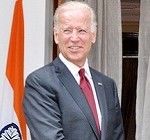U.S. Vice President Joseph Biden’s visit to India this week is meant to correct the vision on bilateral relations, one currently clouded by near-sightedness and in danger of losing additional sight.
His considerable skills as a people’s politician will be tested, as he attempts to rescue this important relationship from the morass of complaints and bureaucratic negligence.
He is also expected to lay the ground work for Prime Minister Manmohan Singh’s visit to the U.S. capital at the end of September which both sides expect would showcase progress and give a sense of rejuvenation. They do not want it to just be Singh’s goodbye visit.
The current state of bilateral relations is exemplified by the wrath of American business and by reactive moves by the Indian government. Over the past three months, the U.S. business lobby has led a vitriolic campaign in Washington against India’s economic and trade policies, ultimately forcing three UPA ministers to run here last month to “explain.”
The U.S. pharmaceutical and IT companies are leading the charge against India’s intellectual property regime as being inimical to their interests. They also say India’s “domestic content” requirements in IT are unfair.
The UPA last week announced relaxation in FDI caps in several sectors, but Washington’s reaction was cold at best to this last-ditch effort.
Biden is expected to raise these issues once again, just as Secretary of State John Kerry did on his visit to New Delhi in June. It is unlikely that Indian policies that have taken nine years of meandering would suddenly straighten out a few months before the general elections. American satisfaction on this front is unlikely in the short time remaining. What is likely is some sort of agreement on a U.S. nuclear reactor before Singh comes to Washington. The Americans forced a deadline of September for an early works agreement between Westinghouse and NPCIL during Kerry’s visit.
Apart from the economic issues, Biden is expected to focus on the U.S. “rebalance” to Asia. Therefore his presence in India is as much a bilateral visit as a signal to China. In a speech before his departure, he said: “We’re all in, this administration, absolutely committed to this rebalance. The president is absolutely committed and so am I. And so is our entire national security and economic team.”
These are good words and will go some distance to calm nerves in Asia. But it is still unclear how the U.S. plans to deal with China if its assertive behavior continues in South China Sea.
Apart from saying that a “peaceful resolution of territorial disputes” and “unimpeded lawful commerce” is in everyone’s interests, the U.S. has not given any signals on dealing with situations as they continue to simmer and heat up. China is blocking every effort to work on a code of conduct with ASEAN for the South China Sea.
India may also want to get an honest readout on the Obama Administration’s assessment of Japanese Prime Minister Shinzo Abe and his more robust foreign policy. Washington has so far shown no enthusiasm for Abe’s “nationalist” outlook. Interestingly, India and Japan are coming closer together and Singh and Abe have struck a bond of sorts.
Then there is the impending departure of U.S. troops from Afghanistan, a policy, which Biden helped draft as one of the early proponents of the pullout. He is best placed to explain why the Americans have once again apparently given primacy to Pakistan on deciding Afghanistan’s future.
The conversation on Afghanistan is likely to be tough as it was during Kerry’s visit. Not much has changed. What has become apparent in the meantime is the re-emergence of an old narrative, encouraged by elements within the Obama Administration, that India should be asked to “do something” in Afghanistan to mollify Pakistan. In fact, an effort is being made to blame the whole mess in Afghanistan on India-Pakistan rivalry. This is hyphenation by the back door.
Unsurprisingly, this has raised hackles in New Delhi apart from raising concerns that when it comes to Pakistan, Washington has a permanent disability to disengage and look at the real issue – state-sponsored terrorism. Beyond a point, the convolutions in U.S. policy towards Pakistan are decipherable only to those who champion them.
Biden and Singh may want to talk more openly about the “Af-Pak” problem when they meet for the message to reach President Obama before Singh and Obama have their own official interaction later in the year.
Singh is believed to be disappointed and even angry at the way Indo-U.S. relations have gone adrift. But he left the stewardship to his senior bureaucrats who let the most crucial issues (nuclear liability law, commercial problems) fester without solutions.
Biden’s visit will hopefully remind both sides that the friendship is rooted in long-term common strategic interests, even goals. He can help revive some of the old fervor because it would be a folly to continue to let things slide.
Seema Sirohi is a Washington-based analyst and a frequent contributor to Gateway House: Indian Council on Global Relations. Seema is also on Twitter, and her handle is @seemasirohi
This article was exclusively written for Gateway House: Indian Council on Global Relations. You can read more exclusive content here.
For interview requests with the author, or for permission to republish, please contact outreach@gatewayhouse.in.
© Copyright 2013 Gateway House: Indian Council on Global Relations. All rights reserved. Any unauthorized copying or reproduction is strictly prohibited.


